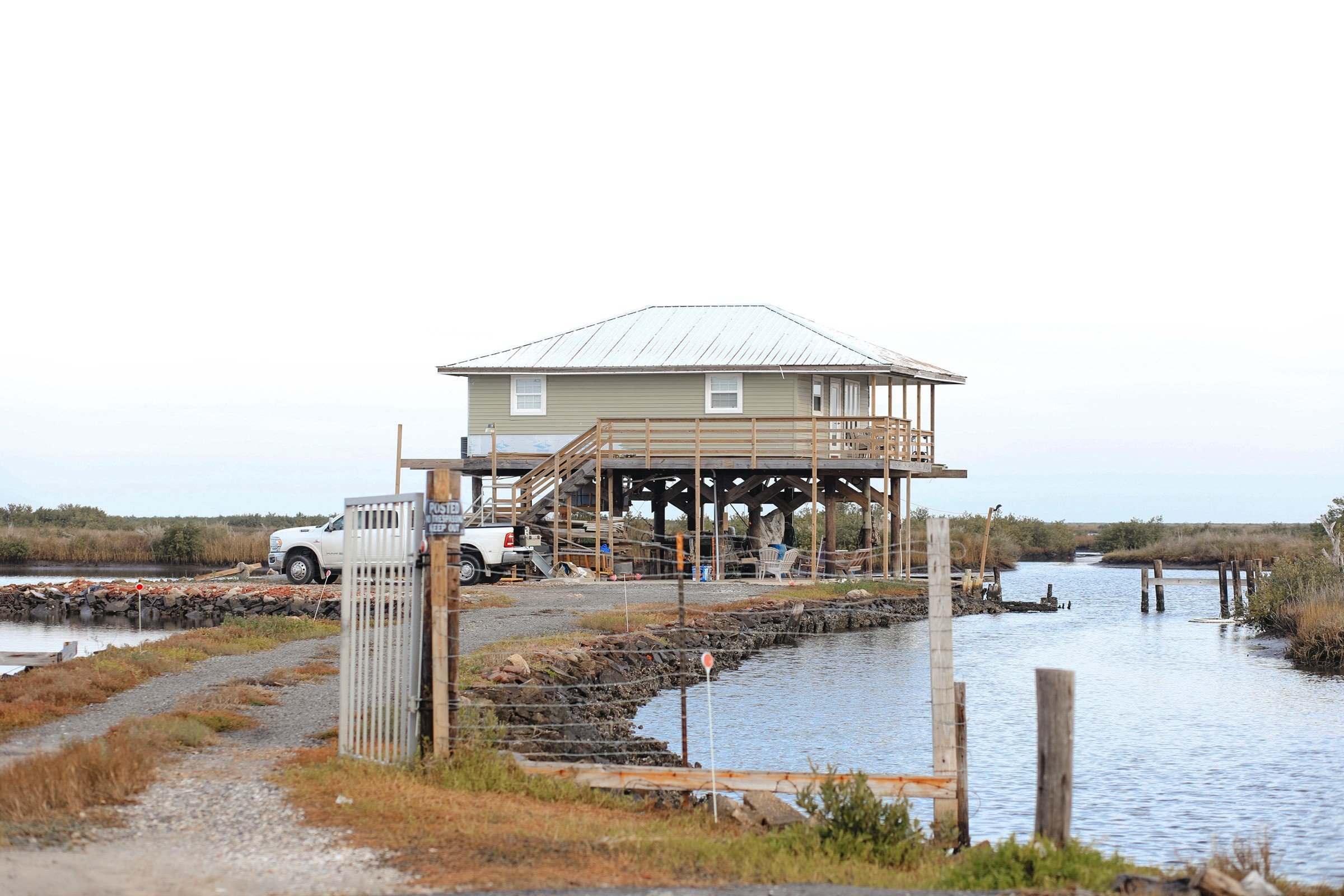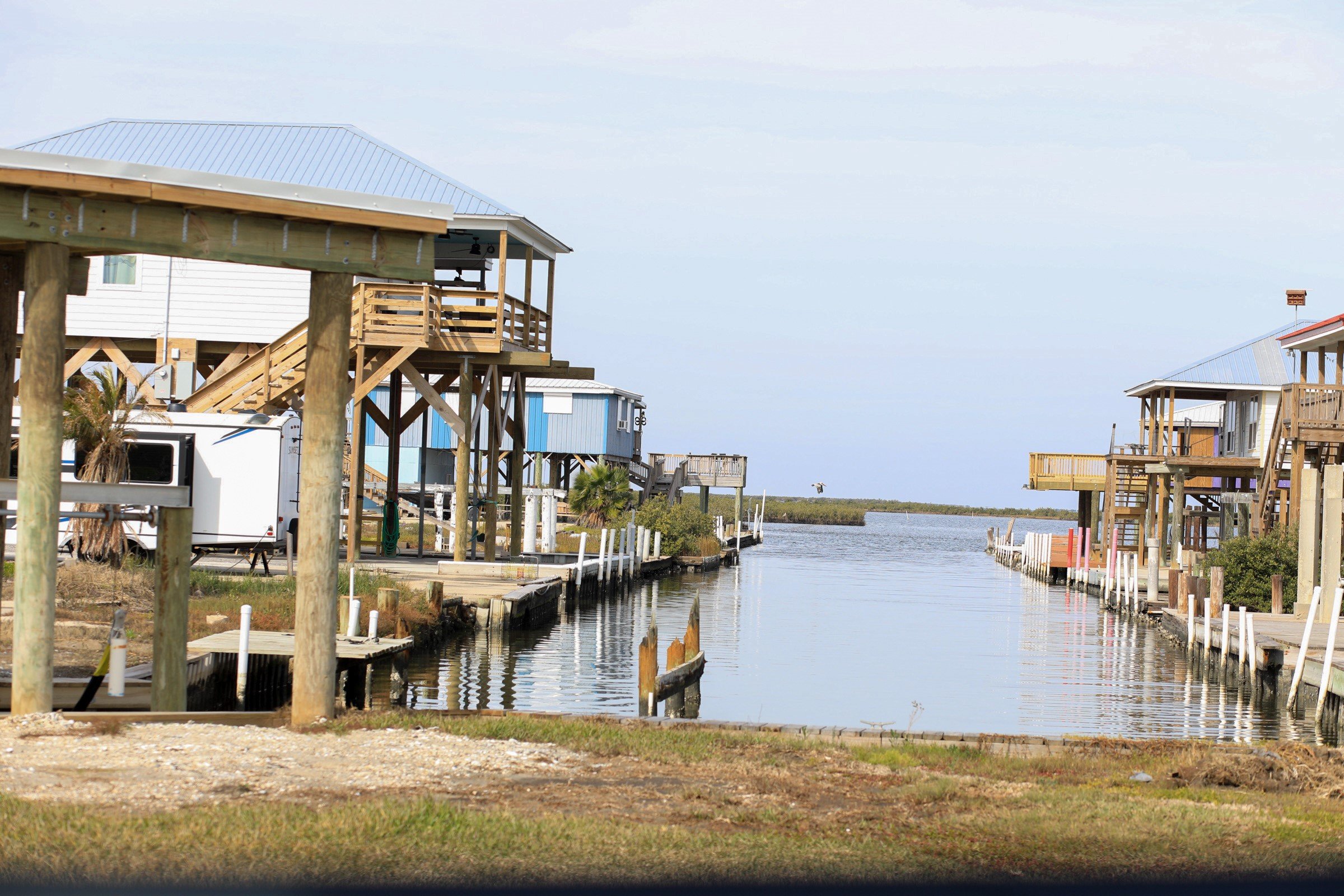Looking on the Bright Side
The Story of Bright Side Oysters & Louisiana's Upcoming Alternative Oyster Culture Industry
Bright Side Oyster Company is a beacon of resilience in the face of adversity. Nathan Herring's farm is located in the waters off of Grand Isle, Louisiana—an area that was in the direct pathways of both Hurricanes Zeta and Ida. Herring has persevered through the struggles of starting an aquaculture business in a nascent industry in an ecologically volatile area. His work ethic, passion, and optimism guarantee that Bright Side Oyster Co will weather any storm that comes its way.
To get to Grand Isle, you leave the city limits of New Orleans, and head south, along US Highway 90, where the exurbs give way to a smattering of rural communities. The highway winds along the bayous through Lockport, then Leeville, where it parallels the water on its western edge. Shrimp nets, booms, and paupiers frame the sky on one side, while half-sunken boats linger on the water's edge on the other.
The highway speeds through Golden Meadow, through the levees, and then into unprotected territory, where the earth pulls away from itself into thousands of tiny islands floating on a quiet sea. Just before Grand Isle, the highway ascends sharply, and plateaus for a moment.
In those seconds, suspended in air, the horizon stretches without end. In the distance, massive oil platforms look like mere specks floating on the hazy Gulf of Mexico. It's overwhelming to think that since 2020, the area has been nearly devoured twice by Hurricane Zeta and then Ida. Something something oyster growing region.
***
"When Hurricane Zeta hit, I was worried I lost everything,"
Nathan Herring, the owner of Brightside Oyster Co, shared with me as we cruised out to his farm on the Gulf of Mexico. "The storm came out of nowhere, and I had to scramble to prepare my farm as best I could before getting the heck out of there." And then, with a simultaneous laugh and sigh, Herring shared "and then less than a year later, Hurricane Ida hit."
Herring is helping pioneer Louisiana's burgeoning oyster aquaculture industry. The thirty-four year-old was one of the first farmers to be awarded a lease by the state in the waters off of Grand Isle to grow oysters. For the past six years, Herring has been making the two hour journey down from New Orleans to Grand Isle to do what he loves—farm oysters. He's apprenticed with other oyster farmers, hustled odd jobs from landscaping to real estate to bootstrap his operations, and he's even resurrected his oyster farm twice—once from Hurricane Zeta in 2020 and then Ida in 2021.
Herring grew up in Starkville, Mississippi and graduated from Mississippi State University with a degree in Wildlife and Fisheries with a focus in aquaculture. After graduation, Herring spent time working for the New York City Parks Department as a part of the Million Trees Initiative, a city-wide program with the goal of planting one million new trees across New York's five boroughs. This deepened Herring's appreciation for ecosystem conservation work. As fate would have it, while in New York, Herring came across a volunteer opportunity with the renowned Billion Oyster Project. Herring learned firsthand about the positive environmental benefits oysters provide. He also met a man around his age who had just started his own oyster farm.
"It was really inspiring meeting someone around my age, without any familial connection to oyster farming," Herring said. "But this guy was passionate enough to learn the ropes himself, and started his own farm and business. I really liked that idea."
There was just one problem.
Since 2002, the Louisiana Department of Natural Resources has had a moratorium in place which halted the leasing of state-owned water bottoms to private individuals for oyster cultivation.[1] Those with existing leases could continue harvesting oysters, but no new leases were being granted at the time Herring was looking to explore aquaculture opportunities in Louisiana.
Up until a few years ago in Louisiana, oysters were exclusively dredged by fishermen who held private leases of designated public oyster lands.[2] Oyster fishermen—as the parlance is in Louisiana—havest oysters from public waters, transfer them to their private lease sites, and redistribute them on cultch. There, oysters grow in reefs on the seafloor until they are dredged and sold when they reach at least three inches in size.[3]
Despite being a perennial leader, Louisiana’s oyster landings have declined in recent years.[4] This decline is due to a number of factors, including losses sustained by Hurricane Ida, a large 2019 flood requiring opening of the Bonnet Carre spillway, and the 2010 Deepwater Horizon BP oil spill.
But all was not lost.
In recognition of the hardships facing the traditional oyster industry, and in an effort to diversify its oyster production, Louisiana authorized Alternative Oyster Culture (AOC). AOC is defined as the production of hatchery-set oysters grown in gear suspended in the water column or on the sea floor. The state reasoned that if oysters were grown in cages, as opposed to on the seafloor, this would allow farmers to raise and lower the cages to protect oysters from predators, fouling, and burial effects of disasters—like hurricanes.[5]
Herring decided to take full advantage of the new aquaculture scene that was developing in Louisiana. In 2018, Herring applied for an AOC lease spot at a then-newly developed "aquaculture park" near Grand Isle. The Grand Isle Port Commission had created eight one-acre farm plots with navigation lanes in between in which residents could apply to lease to create their own oyster farms.
While waiting for his own permitting to go through, Herring began making the two-hour trek from urban New Orleans down to the seasonal town of Grand Isle to work alongside other already-established local farms in an effort to learn the ropes of farming oysters using suspended gear.
"During that time, I was also working any job I could to save extra money from my farm. I did landscaping projects, I sold exercise equipment, I would drive pedicabs in New Orleans. Whatever I could do," Herring chuckled as he reminisced. "Now I can finally say that I'm a full-time oyster farmer."
After several months , Herring's permit for his own farm was finally approved.
"I was the first farm to get approved in my current space near Grand Isle," Herring shared. "It was really cool, but also a little intimidating being the first person in the water in that location."
Herring didn't get his first crop of oyster seed from a hatchery. He got it from Instagram.
Herring won his first 15,000 seed from an Instagram contest held by Alabama's Murder Point Oyster Co. He then quickly purchased another 15,000 seed from a local Louisiana hatchery, as well as some second-hand Oystergro cages from local farmers.
Initially Herring's first season seemed promising. His oysters were reaching market size in just under 8 months, and he was working on the logistics of building out his own sales and distribution network.
Then, COVID hit, and his would-be distribution channels closed up.
Herring intended to take the down-time to continue to build out his farm. However, Herring was suddenly confronted with something not all first-time small-business owners face—hurricane season in Southern Louisiana.
In October 2020, Hurricane Zeta came barreling into Grand Isle, and was a near direct hit to the farm.
"At that time, I had 17 lines of cages full of oysters. After the hurricane passed, the roads down to Grand Isle were still flooded and closed for several days. I had to wait nervously until I could safely journey down and survey the damage," Herring shared, "it was depressing when I got here. I had 4 mangled lines of cages, and everything was strewn around the water and surrounding islands."
Herring estimates he lost 60% of his crop during Hurricane Zeta. He spent the next several weeks recovering cages, and piecing his farm back together. Herring took on a number of side jobs to pay to replace the gear that had been lost and damaged.
Then, in August 2021, Hurricane Ida stormed onto the scene.
"Ida came out of nowhere. The storm intensified quickly, and I wasn't able to fully prepare the farm.," Herring shared, almost pained to relieve the experience. "I got on the water for as long as it was safe, and sunk as many cages as I could."
Ida was more voracious than its predecessor, Zeta, and caused extensive damage to Grand Isle. Over 700 structures on the island were damaged, and the population of full-time residents has never quite recovered.
Again, significant flooding in the area prevented Herring from returning to Grand Isle for several days. When the waters receded, and Herring was able to return, he wasn't faced with the same level of noticeable devastation as he did after Zeta. However, Herring discovered he did have some mortality in the cages that had been sunk to the seafloor—the oysters had been silted over, and many smothered, due to sediment disturbance from the hurricane. Perhaps even more tragically, Herring realized his boat had been damaged beyond repair.
But Herring didn't give up.
He adapted his farm layout, and shortened the length of his cage lines. That way, there was less weight on the anchored lines and, in the event a line did break during a storm, there would be less lost cages. Herring also changed up his cage type to be better protective of oysters should they need to be sunk to the seafloor for an extended period of time during a storm.
A welcome financial reprieve also came from the state. In 2021, Louisiana began subsidizing AOC by providing grants to jump-start this nascent industry.[6] Funding for the new grant program was provided by the state in anticipation of pending salinity changes from large-scale Mississippi River diversions that had the potential to negatively impact the estuaries where wild oysters grew.[7] Herring applied for, and received, a grant to build-out his own nursery.
By the summer of 2022, Herring had not only revived his farm, but had expanded so substantially that he was able to transition to oyster farming full-time. He currently spends two night a week at his camper in Grand Isle in order to ensure he works his farm three days a week. Herring then splits the remainder of his week doing sales, deliveries, and events with local restaurants to expand his sales market within greater New Orleans.
"I know that it is unrealistic to distributors to come down to Grand Isle to pick up oysters because it is such a distance out of the way," Herring confessed, "but I'm taking the opportunity to use my network in New Orleans to create new markets for my oysters."
The waters around Herring are now beginning to fill with new farmers. Once the only farm in the area, Herring now shares the Grand Isle aquaculture park with ten other farms.
"Nearly all the farmers are young—in their 20s and 30s," Herring shared. "Aquaculture is definitely something that young people are interested in being a part of. Plus, restaurants and people in the service industry are interested in supporting local farmers in working together to cultivate our growing alternate oyster culture industry."
To date, there are over 19 oyster leases operating on 50 acres of water utilized for AOC. A total of 219 acres have been set aside for AOC farms.
As Herring and I were headed back from the farm, I had to ask "so the name, Bright Side Oysters . . . ."
I stopped mid-question.
After building a farm in an infant industry and surviving not one but two infamous hurricanes, and to persist and thrive in the face of these adversities . . . the answer is obvious
Citations
[1] LDWF Announces Process to Lift Oyster Moratorium | Louisiana Department of Wildlife and Fisheries. The moratorium was established because of user conflicts within the coastal zone, especially as it related to coastal restoration activities performed by the state.
[2] Wicker, Karen Miriam, The Development of the Louisiana Oyster Industry in the 19th Century, (1979). LSU Historical Dissertations and Theses. 3362. https://repository.lsu.edu/gradschool_disstheses/3362
[3] The Louisiana Oyster Task Force is comprised of these private leaseholders, members of the Louisiana Department of Wildlife and Fisheries and the office of Governor John Bel Edwards
[4] Louisiana’s oyster landings averaged 11.6 million pounds per year between 2000 and 2019, but has averaged only 5.3 million pounds per year between 2020 and 2021.
[5] Coastal Clips, Louisiana Sea Grant College program at Louisiana State University, Baton Rouge (Vol 60), available www.laseagrant.org/wp-content/ (last accessed 01/25/2024).
[6] In order to promote AOC, the Louisiana ____ recently authorized 21 start-up grants up to $45,000, for farmers to cover some, but not all, investment costs. and eight grants for nurseries ($15,000 each) awarded to twenty-three individuals (Louisiana Sea Grant 2022a, 2022c, 2023b). Additionally, a $225,000 grant was awarded for a hatchery and four $100,000 grants were awarded to established AOC parks (Louisiana Sea Grant 2022b, 2023; Louisiana’s Seafood Future 2023a)
[7] Indeed, AOC is one of several oyster impact mitigation strategies outlined in the environmental impact statement for the Mid-Barataria Sediment Diversion (Louisiana’s Seafood Future 2023b, USACE 2022).












